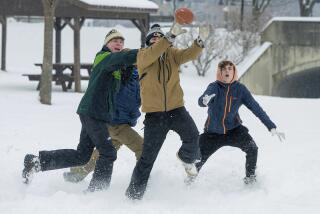Winter Warmth Gripping Midwest; Wheat Imperiled
- Share via
CHICAGO — Winter is missing much of the Midwest this year.
Unusually mild temperatures--balmy for the season--and unusually low snowfall have combined to make the last two months, normally frigid, among of the mildest on record.
Across the Great Plains, the unseasonable weather is threatening the nation’s winter wheat crop. In parts of northern Illinois, Canada geese, fooled into thinking it’s spring, have begun their mating rituals weeks early. In Michigan and parts of Wisconsin, winter resorts are having tough sledding.
“What happened to winter? It’s up in Alaska, and that’s a good place for it,” said Clem Goushas, a National Weather Service forecaster in Chicago.
“Winter? I had to go to Upstate New York to find it,” said Jack May, the government’s chief meteorologist in Topeka, Kan.
It is the fourth warmest January in more than a century in St. Louis, the ninth warmest in Milwaukee and the fourth warmest in Youngstown, Ohio. There has been 18% more sunshine than normal in Cleveland this month, and Detroit, experiencing its third sunniest January ever, has had less than half its normal snowfall.
One for the Books
“This month is definitely going down in the record books,” said John Haase, a government meteorologist in Milwaukee.
The nation’s metropolitan snow capital, Buffalo, N. Y., has had only 17.3 inches of snow, less than a third of the total it normally gets by the end of January.
In Kansas, the nation’s biggest producer of winter wheat, warm temperatures are allowing aphid-like greenbugs--normally killed by the cold, to lunch on the tender young wheat planted last September. And lack of snowfall is robbing the plants of moisture and of a protective blanket that normally would shield the crop from wind damage.
In central Kansas, temperatures have averaged almost 11 degrees above normal so far this month, and snowfall this winter is almost 11 inches below normal. “If nothing changes, it could be a disaster for the wheat crop,” said Kansas extension agronomist Jack Brotemarkle. “We could see a 25% reduction in the crop.”
The temperature has not dropped below zero in Chicago once this winter. If that continues, it will be only the 10th time that that has happened since 1872. Normally, there are 14 below-zero days in the Windy City during December, January and February, the three months that the National Weather Service officially calls winter. Cleveland, which averages seven days below zero each winter, has also missed the zero mark so far.
January, usually Chicago’s cruelest, coldest, snowiest, most miserable month, has been early-spring warm. Temperatures have averaged 9 degrees above normal, with highs reaching into the 50s on a few days and into the mid-40s on many.
In both 1967 and 1979, January blizzards paralyzed the city, but this month Chicago has had only four-tenths of an inch of snow. Only in 1934 was less snow recorded.
“Less than a half-inch of snow, that’s remarkable,” said Paul Merzlock, a weather service forecaster in Chicago.
With above-normal temperatures forecast for the remainder of the month, it appears that this January will enter the record books as the city’s 10th warmest January in the last 117 years.
Sap Rising Early
The warm temperatures have triggered premature signs of spring. In forest preserves around Chicago, sugar maple sap is moving through the trees weeks ahead of schedule, mourning cloak butterflies have come out of hibernation early and hikers are reporting unseasonable clouds of midges, tiny, fly-like insects, according to Ron Losew, senior naturalist for the Cook County Forest Preserves.
In Michigan, the lack of snow, the abundant sun and the warm temperatures are being blamed for a relatively dismal ski season.
“Surviving we are, but flourishing we’re not,” said Mark Tibbitts, general manager of the Pine Knob Ski Resort in Clarkston, Mich., north of Detroit. “It’s psychological. With no snow on the ground (except artificial snow at some ski resorts), there is no interest in skiing,” Tibbitts said.
However, nights at Pine Knob have been too warm even to make artificial snow. “We’ve been able to make snow only three of the last 14 nights. Usually we’d have made snow at least six of those nights,” he said.
“Getting through January like this,” said Walt Drag, a weather service meteorologist in Cleveland, “has taken a lot of the sting out of the season.”
It certainly was better than being in central Alaska, where it was 126 degrees colder in Tanana than it was in Chicago on Friday. That little Alaskan community reported a record 76 degrees below zero.
More to Read
Sign up for Essential California
The most important California stories and recommendations in your inbox every morning.
You may occasionally receive promotional content from the Los Angeles Times.













